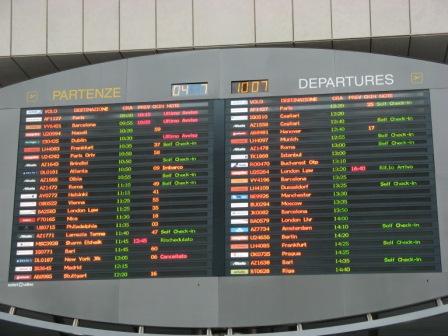
I went to the airport one morning two weeks ago, and there I discovered that there is a dark side to cruising. The only thing surprising about that is that I was surprised.
Going home from vacation is never very much fun, but it would seem that Marco Polo airport was designed to get you accustomed really fast to the fact that the fun is seriously over.
As I have often mentioned — sorry if I’m becoming repetitive, maybe I should set some of this material to music and we could all join in on the chorus — Venice has become a mega-major passenger port.
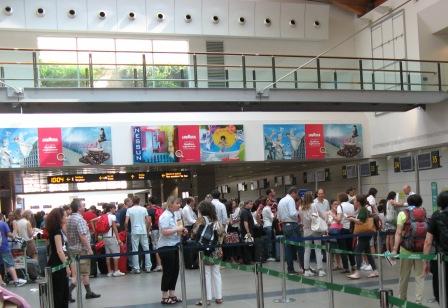
Cruise traffic in the last ten years has quadrupled. Expressed in bodies, that comes to 1,420,980 in 2009, which represented a 16.9 per cent increase over the previous year. Venice is now the fourth busiest port in Europe, and the first in the Mediterranean.
The first ship on the dance card this year was the Costa “Deliziosa,” which arrived on January 30 (I don’t know from where — maybe there’s a cruise-ship launching platform somewhere around Queen Maud Land). The last one scheduled this year is the MSC “Magnifica,” which will depart on December 27. The word “season” has taken on new meaning: It’s every month of the year except January.
But until last Sunday, I hadn’t really given any thought to what these numbers might portend, not so much to the ships as to the airport.
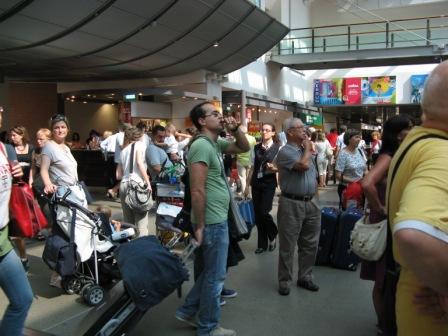
After all, passengers mostly arrive by air. I’ve often seen the young women who serve as cruise-passenger wranglers waiting in the Arrivals area at Marco Polo airport, holding up their signs for Princess or Costa or whatever the cruise line might be, to help them gather their arriving clients, each of whom appears to bring about ten metric tons of luggage. The common idea about cruises is that people go on them in order to eat constantly, like blue whales (daily requirement: about 1.5 million calories). But when I look at their bags, I think their main plan must be to pass the time changing clothes.
Anyway, it’s obvious that extraordinary machinery has been developed to keep these ships and their passengers and their supplies coming in and going out, doing a turnaround in the space of a day, for 11 months a year.
It doesn’t appear, however, that the same efficiency has been devoted to the airport phase of the experience. Because when six or seven cruise ships come into Venice on a Sunday morning to finish their dreamy voyages, most of those people head for the airport. Where the party is definitively over.
Venice airport is the third busiest in Italy, preceded only by Rome and Milan. This makes the airport people very proud, as well it should. But while their annual numbers might be impressive on the page, they’re not nearly as impressive as the struggle all those thousands of people have to make in order to leave Venice in something like a four-hour window of time. Certainly there are early flights where the density of humans is less — the first departs at 6:35 AM. But no cruise company in the world would put its passengers on the airport bus at 4:30 AM, unless it were docking in Murmansk.

So as I say, I went to the airport on a Sunday morning to meet some friends who had disembarked from their cruise and were flying out that night. When I slid off the escalator on the Departures level, what greeted me was an appalling combination of the last day at summer camp (when all the kids are milling around being picked up by parents) and Buffalo Bill’s Wild West featuring Annie Oakley.
That morning there were 20 flights scheduled between 9:50 AM and 12:15 PM; that’s one every six minutes. And three of those flights were to major US destinations, Atlanta, Philadelphia, and New York. I mention that only because I presume that one flight to Atlanta involves more passengers than three flights to Palermo.
When I think back on the previous facility 15 years ago (a nostalgic reminder of the Oneida County airport at Utica, New York in 1968), the shiny new version is something of an improvement. But one has to ask oneself (I’ll stand in for “one,” in this scene), what they were thinking when they designed an airport that has more space for the planes than for the people.
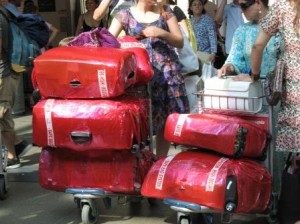
But wait. It turns out there are more than 25 people who need to line up at each counter, so they begin to clump together. And hold on — we actually need lots and lots of space for the people who are walking from here to there because many of them got here the necessary two (or more) hours before departure but whose flight isn’t open for check-in yet. So they wander (mill around, actually) or they sit, if they can find a place among the very designy but not very numerous seats.
Let’s talk about other things people need besides enough space to stand in a check-in line, or to sit and check their tickets and yell at their kids and or maybe take a snooze.
People need to go the bathroom. There are two obvious bathrooms on the Departures level and one hidden away down a hallway. I don’t know about the men’s room (men don’t care, anyway), but each ladies’ room has two (2) toilets. That makes four stalls for women on a floor that is pullulating with hundreds and hundreds of people. There are two ladies’ rooms on the Arrivals floor, too, so make that another four stalls on the ground level. Eight stalls — I mean ten, if you count the hidden facility — for women in an airport that operates an average of 80 flights a day, or an average of one every 12 minutes. (There must be a handicapped-accessible bathroom somewhere, it just doesn’t come to mind.)
Lest you think I am unreasonably obsessed with physiological needs (like, say, space to move around in and yes, to relieve oneself), I have some data from Robert Davis, an architect friend of mine. He writes: “We have a rule of thumb for theaters which is ’30 seats per seat.’ … So a 600-seat facility should have 20 fixtures, evenly divided male/female.”
Assuming that airport design is not radically different from theater design (some people spend more time in airports than they do in theaters, after all), if you have 600 people in the airport you would need ten stalls for the women. So we see that the Venice airport is already in a bathroom deficit situation. Because let’s assume there are more than 600 people in the airport at a given time, a pretty safe assumption based on the evidence of the other morning. The people keep swarming in, but there are still only eight stalls. Just deal with it.
At the other end of the alimentary canal, there are two (2) bar/sandwich counters (one upstairs with no seating and one downstairs with some tables), and one multi-station buffet with very little space to move around in with your tray, and a batch of cramped tables and extremely little space for your luggage, assuming you’re snacking before checking in, or you feel like doing something other than wander and look for a place to sit. The line for this facility stretches out to collide with the lines of people checking in at counters 59 and 60.
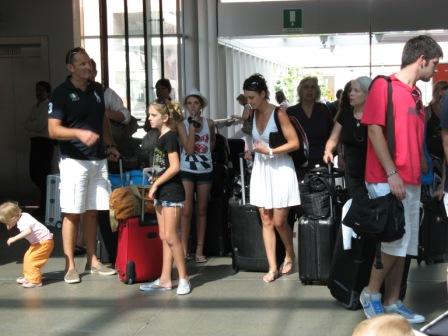
I have to say, pretty slim pickings for passengers at an airport which claims to be ready to handle 15 million passengers a year. Especially considering that it is currently handling only about 8 million.
I’m not saying Venice’s aerodrome has to be like Frankfurt or Amsterdam airports, though I wouldn’t mind. All I’m saying is that while everyone has been working night and day to increase cruise traffic, it doesn’t appear that anyone has been attending to how they will be accommodated (I mean wrangled) on the day they leave. So far, Skytrax has not awarded any stars at all to Venice airport. I wonder what that means.
So what advice could I give someone leaving their dream cruise and flying out of Venice airport in the summer? Bring a book. Your own food. A folding chair. A portable toilet. Think of it as camping, in the middle of Times Square. You’ll be fine.
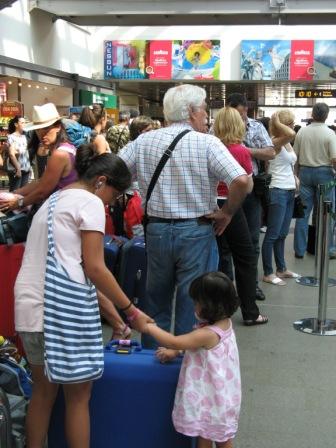

10 Comments
LOL – had the same experience on Monday.
Check-in to Vienna was next to the Atlanta Check-in …
Next time I will follow your advice: Bring a book. Your own food. A folding chair. A portable toilet. Think of it as camping, in the middle of Times Square. ;o)
I’m sorry to hear that you had to go through this experience, but I’m glad you survived it. Please come back another time, it’s not ALWAYS like that.
“….maybe I should set some of this material to music and we could all join in on the chorus…”
Have a boo at this results page for ‘Complaints Choirs’ on YouTube; perhaps you will be inspired…
http://www.youtube.com/results?search_query=complaints+choirs&aq=f
Brilliant idea. I would happily write — no wait, I guess that ought to be “unhappily write” — a Complaints Song and organize a choir. If I could just find the time. That would be my first complaint…
The pictures you’ve posted say it all. I feel for you. Looks kind of traumatic. lol We’re suppose to go on cruises and vacations to relieve ourselves from stress and just to get away from it all. But with this scenario, it seems like we’re getting ourselves signed up for one heck of a stress-a-thon! And what better way to commemorate a getaway than to be crammed into a crowd of unfamiliar faces and bodies, all of which are sweaty and irritable. I could just imagine the tension this will bring about to a family, not to mention the kids. whew!
They say there’s a new, improved, 25%-more-absorbent, expanded airport in the planning stages. Like most large projects, its realization will almost certainly reveal it to have become inadequate. What I don’t understand is where the global financial crisis fits into this scenario. Every time we see the pachyderms sailing in and out, crammed to the gunwales with happy travelers, I can’t figure out how they can afford it. But what, as I often ask myself, do I know?
The nearby Treviso-Canova airport has recently been modernized with all-weather certified landing aid equipment. That should allow for a partial diverting of air traffic and closure of Venice Marco Polo airport, if there is a will to expand the terminal buildings.
What a curious and original solution. Your idea of its being a viable alternative to Marco Polo sounds to me a little bit like suggesting that instead of expanding JFK, we just start re-scheduling New York flights to Hartford. Necessary? Maybe. Appealing? Not at all.
Arrivals can be a mess at Marco Polo, too–and not just during the cruise season. A couple of years ago, my wife, dog, and I arrived at VCE from Paris in early February and discovered that one of our suitcases hadn’t made the plane. I had to stand in line nearly three hours to file a lost-luggage report.
It must be something global — I had to deal with a long line at Dulles Airport outside Washington to get my mitts on my suitcase, which it turns out wasn’t LOST, just sent elsewhere in the facility. Is it possible that you were there in the throes of Carnival traffic? Or was there only one person on duty?